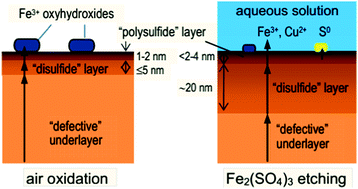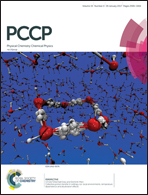Layered structure of the near-surface region of oxidized chalcopyrite (CuFeS2): hard X-ray photoelectron spectroscopy, X-ray absorption spectroscopy and DFT+U studies†
Abstract
The depletion of oxidized metal sulfide surfaces in metals due to the preferential release of cations is a common, but as yet poorly understood phenomenon. Herein, X-ray photoelectron spectroscopy using excitation energies from 1.25 keV to 6 keV, and Fe K- and S K-edge X-ray absorption near-edge spectra in total electron and partial fluorescence yield modes was employed to study natural chalcopyrite oxidized in air and etched in an acidic ferric sulfate solution. The metal-depleted undersurface formed was found to consist of a thin, 1–4 nm, outer layer containing polysulfide species, a layer with a pronounced deficiency of metals, mainly iron, and an abundant disulfide content but negligible polysulfide content (about 20 nm thick after the chemical etching), and a defective underlayer which extended down to about a hundred nm. DFT+U was used to simulate chalcopyrite with increasing numbers of removed Fe atoms. It was found that the structure with disulfide anion near double Fe vacancies, and the ‘defective’ structure comprising Cu in the position of Fe and Cu vacancy are most energetically favorable, especially when using a higher Hubbard-type parameter U, and have a large density of states at the Fermi level, whereas polysulfide anions are stable only near the surface. We propose a mechanism explaining the formation of the layered undersurface and ‘passivation’ of metal sulfides by (i) arrested decomposition of a nearly stoichiometric sulfide surface, and (ii) faster interfacial transfer and solid diffusion of cations towards the surface; (iii) stability limits for specific defect structures, promoting their expansion in depth rather than through compositional changes, excluding surface layers; (iv) decay of surface polysulfide layer yielding elemental sulfur.



 Please wait while we load your content...
Please wait while we load your content...